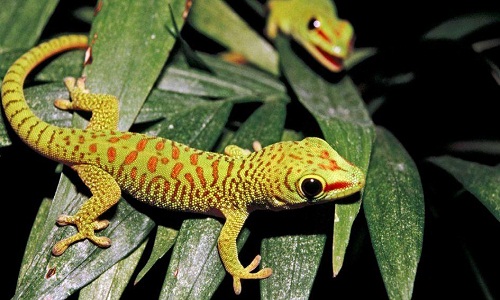6 interesting possibilities of geckos
Self-hanging, clinging to vertical walls or self-tailing are special features of geckos.
Discover the exciting possibilities of geckos

Geckos use dew seeds on the leaves to cleanse themselves.(Photo: National Geographic)
Self-cleaning
A new study shows that geckos use dewdrops on leaves to clean themselves . Gecko bodies contain thousands of hemp fibers with air sacs that are responsible for pushing water out when they stick to water.
Experts say many recent studies show that rolling water droplets can clean impervious surfaces on leaf and insect stalks, but this is the first time this phenomenon has been observed in animals. vertebrate. They found that every particle of water could clean the dust and dirt on the body .
Move acrobatics
Geckos move on vertical surfaces suspended from the ceiling because they can quickly convert the adhesion of the toes.
Gecko-shaped toes contain hundreds of small hairs called hard feathers. These hairs differ from hemp fibers that push water on the skin. Scientists know that geckos are capable of creating "sticky feet" when hairs are in close contact with the surface under the influence of molecular bonding forces (Van der Waals force).
They built a mathematical model to explain the mechanism of this binding hair. The hairs protrude and deflect at a certain angle, when they bend to a level near the horizontal, the contact surface of the gecko section increases, creating a larger surface area of adhesion and supporting gravity. .
The hairs are also very flexible and allow geckos to jump high or change direction in a snap . If necessary, hairs can also be absorbed and then diverted to help the gecko quickly escape.
Use your tail to balance when slipping

By tail rotation, a gecko can safely land.(Photo: National Geographic)
According to a study from 2008, gecko tail twists can help them land safely on their feet .
Experts use high-speed cameras to observe geckos moving on slippery vertical surfaces. On a non-slip surface, the tail geckled upwards in the air. However, when encountering slippery places, the tail geckos leaned against the wall " like the 5th emergency foot ".
In one test, geckos lost their ability to bond surfaces. When falling, it tails its tail and stretches its body, then turns its tail to rotate its whole body. Once completely upright, the gecko stopped rotating its body and took only 100 milliseconds.
Self-tails
Geckos can tail themselves. However, until now, the reason for their easy removal from the tail is still unclear. According to a 2012 study, scientists found geckos that form "proportional lines " that help the tail to separate itself from the body, if the predator snatches them from behind.
Using large power microscopes, they observed the gecko tail and were surprised to see the solid lines at the intersection of the body and tail . Strange mushroom-like structures are thought to create cohesion into the body until they are separated from the body.
Flipped
When the tail is lost, the tail is detached, not only standing still, but also flipping, jumping and tumbling for 30 minutes. Signals are responsible for movements within a segment of the spinal cord at the end of the gecko tail. When the tail is still attached to the body, the nerve signal from the gecko affects the control center.
Foot adhesive
Special gecko pins stick in wet environments. Moisture in the air makes the hairs on the legs become softer and more easily deformed. Therefore, in hot weather, lizard feet have better adhesion properties when it is dry.
Many studies show that moisture helps geckos create a strong bond between hairs and contact surfaces, and also allows them to peel their legs easily.

Special lizard foot structure with high adhesion.(Photo: Keller Autumn)
- Flying and stealth geckos of Vietnam
- Russia is about to bring geckos to the universe
- Discover the only new gecko species in the world
- Beautiful photo: Gecko disco dance
- Gecko species have the ability to
- Detecting geckos climbing faster in wet environments
- Decode the anti-slip mechanism of gecko feet
- Decode the ability to climb walls of geckos
- Russia put geckos on the universe
- Vietnamese scientists discovered new geckos
- Detecting species of geckos stripped like fish, reddish like mice
- Detecting fossil geckos in the oldest amber
 Animal 'suffering' after hibernation
Animal 'suffering' after hibernation Why do goats climb well?
Why do goats climb well? Scientists were surprised to see chimpanzees eating turtles
Scientists were surprised to see chimpanzees eating turtles Giant catfish died deadly due to drought in Thailand
Giant catfish died deadly due to drought in Thailand Shocking discovery about the Earth's 'tail'
Shocking discovery about the Earth's 'tail'  Rare mirage of comet's second tail as it approaches Earth
Rare mirage of comet's second tail as it approaches Earth  Argentina discovered fossils of herbivorous dinosaurs 90 million years ago
Argentina discovered fossils of herbivorous dinosaurs 90 million years ago  All cats have long tails, so why is the lynx's tail so short?
All cats have long tails, so why is the lynx's tail so short?  Rare rabbit-tailed cat breed in the land of Phu Tang
Rare rabbit-tailed cat breed in the land of Phu Tang  Chile discovered a new 'armored' dinosaur with a strange tail
Chile discovered a new 'armored' dinosaur with a strange tail 